How to Make Green Sauce: an easy (clean-out-the-fridge) herb sauce!
Have you ever bought a bunch of herbs, only to have most of the bunch wilt away and die in your fridge? AHH! Instead of tossing leftover herbs in the compost or trash, I have a recipe for you that will transform them into something magnificent: GREEN SAUCE.
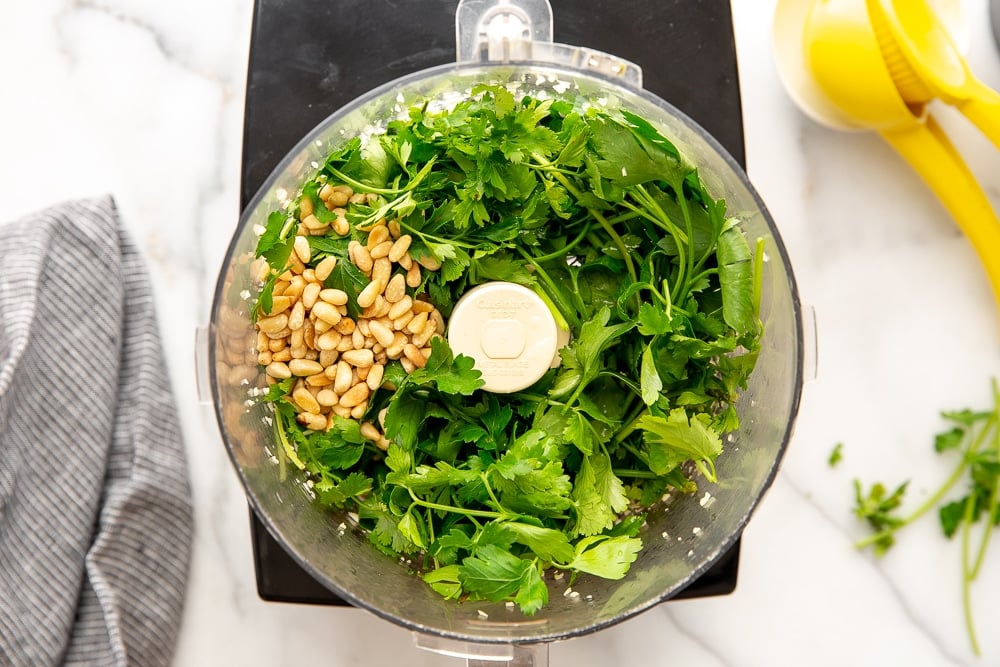
Green Herb Sauce
This green sauce is such a natural part of my life that I never previously thought to share the recipe. It's like my one-bowl salad, which I make almost nightly, blindfolded, with one hand behind my back (ha! not really, but I could). It all started a few years ago. I was rummaging through my fridge and discovered a wet brown sludge at the bottom of my vegetable drawer (ewwww!). The culprit was an old bunch of cilantro, left to slowly die after I had used the two tablespoons called for in a recipe. This was not the first time I had to throw away an old bunch of herbs. But it was one of the last.
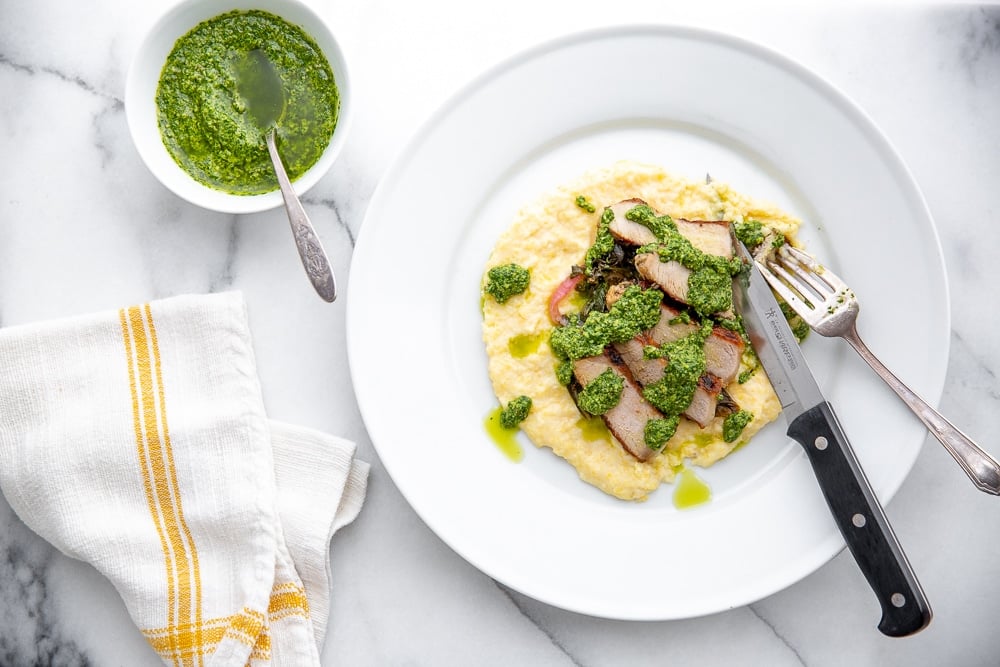
This green herb sauce has since become as routine as making my bed (oh okay, James usually makes the bed, but you get the point). Every week or two I take stock of the leftover herbs in my fridge (I always have fresh herbs on hand, firmly believing that they're one of the best ways to transform ordinary dishes into bright, happy ones), and I whiz them up into a pesto-ish sauce that we use on everything from pasta, to grain bowls, to roasted veggies, to baked fish, to grilled pork chops (shown above), to grilled cheese sandwiches… I could go on.
How to Make Green Sauce
- Green sauce works best with leafy herbs-the ones you typically buy in bunches-including parsley, mint, cilantro and/or basil (although you can also throw in a few teaspoons of stronger herbs, such as rosemary, thyme, tarragon or chives). You can use just one herb, or a mix.
- The herbs go into a food processor with garlic for flavor, toasted nuts or seeds for body, and acid-citrus juice or vinegar-for brightness.
- The finishing ingredient is olive oil (and sometimes water, for a lighter texture), which smooths everything into a beautiful, spoonable sauce.

This isn't a strict recipe, but rather a technique. Once you master the formula, and you tune into your own palate and preferences, you can whip up a variety of different sauces, from a classic pesto, to chimicurri, to chermoula and a coconut chile sauce (see all of the variations below!).
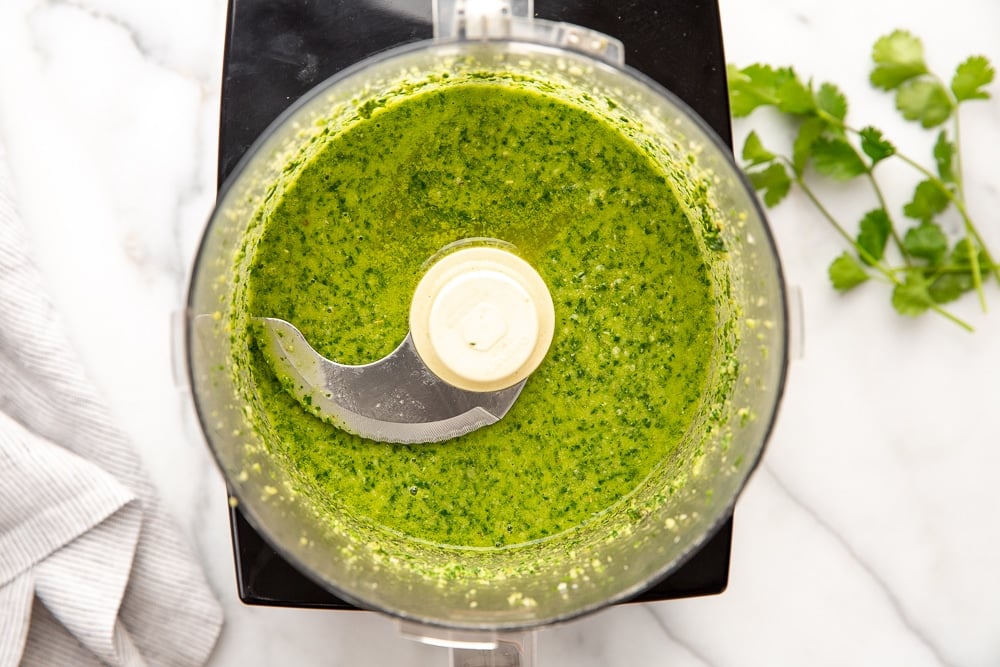
Green Sauce Variations
While you can keep things simple, you can also spice things up (figuratively or literally), with pantry staples, including spices, cheese, chiles, honey or even shredded coconut. This is your chance to get creative and have fun. Start small and taste as you go, adjusting the flavors as your palate sees fit. Below are some of my favorite variations.
- Pesto: Basil, mint and/or parsley (you can use just one or do a mix!), pine nuts, lemon juice. Add-ins: grated Parmesan and/or Pecorino
- Italian Salsa Verde: Parsley, walnuts, red wine vinegar. Add-ins: anchovy, oregano, grated Parmesan (if you have any hardy fresh herbs, such as rosemary or thyme, you could add a teaspoon as well)
- Chimichurri: Cilantro and parsley, red wine vinegar (no nuts). Add-ins: jalapeño pepper, shallot, oregano
- Chermoula: Cilantro and parsley, lemon juice (no nuts). Add-ins: red pepper flakes, cumin
- Coconut Chile: Cilantro and mint, pumpkin seeds, lime juice. Add-ins: jalapeño pepper, shredded coconut, honey
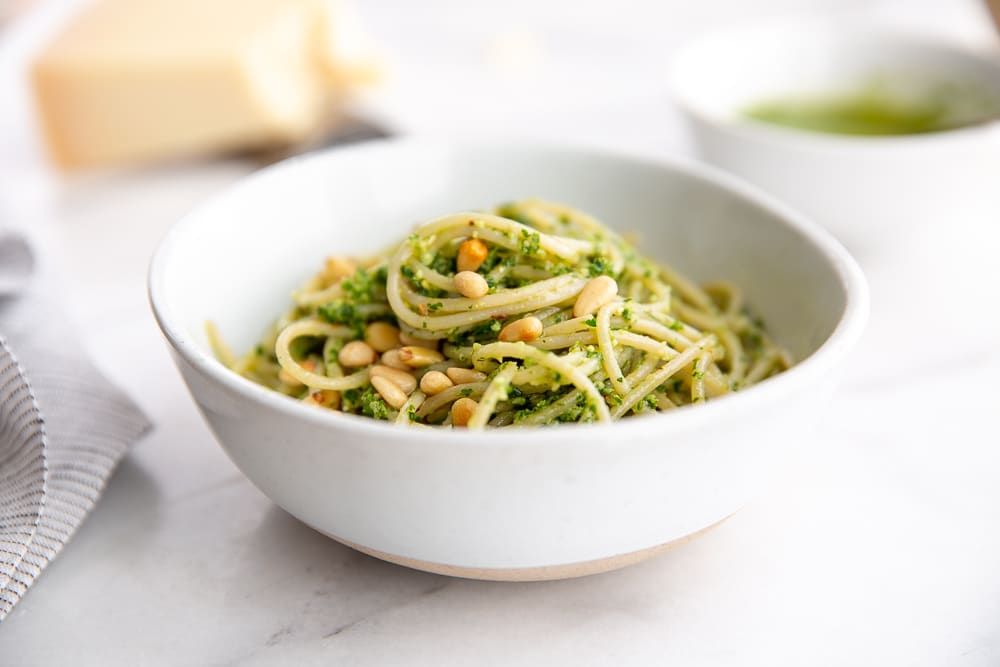
Green Sauce Tips:
- This is more of a technique than a recipe. You can use a handful or two (or three) of any leafy green herbs you have on hand (parsley, cilantro, basil and/or mint). You can also throw in a few teaspoons of stronger herbs if you have them, such as rosemary, thyme, tarragon or chives. From there, taste as you go! This is your sauce, so it should taste good to you. Don't be afraid to splash in a bit more lemon juice, lime juice or vinegar (taste first though, because once it's in it can't come out), or add more nuts to taste. Also, be sure to season well with salt and pepper. The key is to find a balance of flavors.
- Check out the video to see how I store my herbs and make the sauce. I use these reusable green bags.
- Feel free to use the tender upper stems of cilantro and parsley, which are perfectly edible. For basil and mint (and any of the woody herbs, like rosemary and thyme), use only the leaves.
- You will need a food processor to make this sauce. I use a 14-cup model, which can handle anywhere from 1 to 3 or 4 cups of herbs. If you only have about ½ cup of herbs or less, you'll need a mini food processor. (I use both models all the time, and you can find a ton of other food processor recipes in The Food Processor Family Cookbook).
- This sauce is amazing on grilled or roasted meats, fish, pasta, sandwiches and grain bowls. For more one-bowl meal ideas that are perfect for this sauce, check out my book Build-a-Bowl.
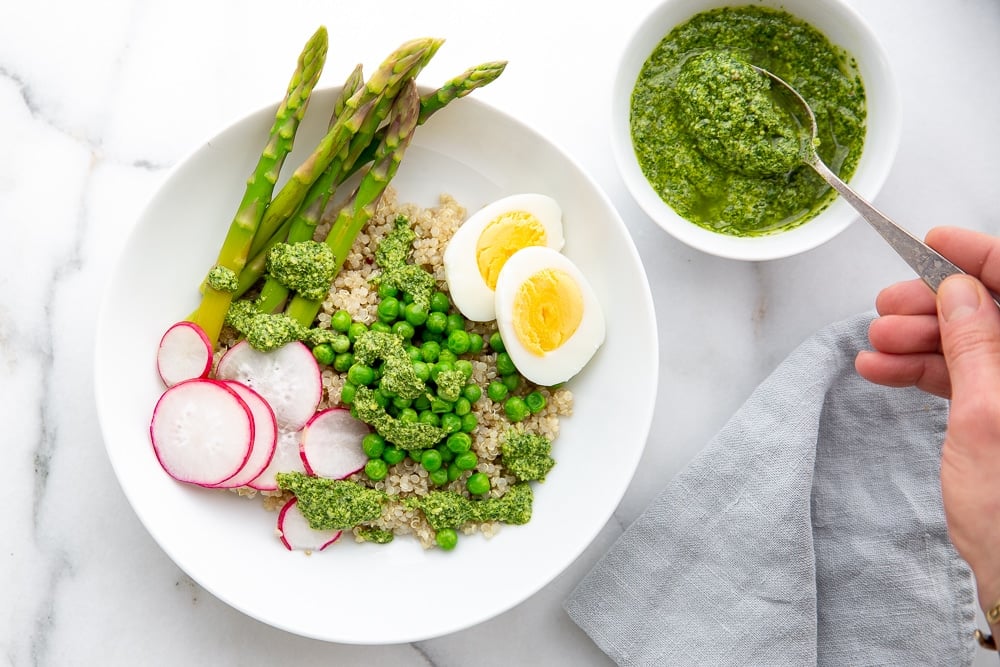
Soon green sauces will become as natural as making your bed. Just a whole lot tastier.
Other easy sauces to try:
- Creamy Cilantro Yogurt Sauce (for fish, chicken, lamb, tacos & more)
- Mojo Sauce (with Grilled Skirt Steak Tacos)
- Cilantro Lime Dressing (with Healthy Taco Salad)
- Green Tahini Sauce (with Mediterranean Quinoa Bowls)
- Cilantro Lime Pesto (with Shrimp Tacos)
- Sweet Pea & Mint Pesto (with Maple Roasted Salmon)
Other recipes you might like:
- Healthy Italian Tuna Pasta Salad
- Baked Turkey Meatballs
- Slow Cooker Salmon Power Bowls
- Broccoli Pasta Bake
- Instant Pot Pinto Beans (and how to serve them)
Watch the Video
Get the recipe!
How to Make Green Sauce (Vegan, Gluten Free
Ingredients
Base
- 1-2 garlic cloves
- 1-3 cups lightly packed parsley, cilantro, mint and/or basil
- 2-4 tablespoons (or more to taste!) toasted nuts or seeds, such as pine nuts, almonds, walnuts or pumpkin seeds
- Fresh lemon juice, lime juice, red wine or sherry vinegar (*see note below)
- Salt and freshly ground black pepper
Optional add-ins (see the notes below!):
- 1-2 anchovy fillets
- ½-1 small shallot, chopped
- ½-1 seeded jalapeño pepper
- ¼-1/2 teaspoon red pepper flakes or Aleppo style pepper
- ½-1 teaspoon dried oregano
- ½-1 teaspoon ground cumin
- 1-2 teaspoons honey
- 2-4 tablespoons grated parmesan or pecorino cheese
- 1-2 tablespoons shredded unsweetened coconut
To Finish
- 1-2 tablespoons water (optional)
- Extra virgin olive oil
Instructions
- In a food processor with the blade running, drop the garlic through the feed tube to chop. Add the herbs (whatever you have-feel free to use a mix!) and nuts or seeds. Process until finely chopped.
- Add a splash of lemon juice, lime juice or red wine vinegar. I usually squeeze in the juice of a ½ small lemon or lime, or start with about 1 teaspoon of red wine vinegar (remember, you can always add more but you can't take it out!). Season with salt and pepper. If using any add-ins, add them now and puree until finely chopped.
- If you prefer a lighter sauce, add a tablespoon or two of water. With the motor running, drizzle in extra virgin olive oil until you get a spoonable, pesto-ish consistency.
- This is the most important step: taste the sauce! This is your time to adjust the seasonings as desired. More nuts will thicken up the sauce, a splash more acid will give the sauce more spunk, and another drizzle of olive oil will round things out. There should be a good balance of flavors, and the final result should taste good to you. If you have the time, let the sauce sit, covered, for 15 minutes to allow the flavors to meld before serving.
Notes
- This is more of a technique than a recipe. You can use a handful or two (or three) of any leafy green herbs you have on hand (parsley, cilantro, basil and/or mint). You can also throw in a few teaspoons of stronger herbs if you have them, such as rosemary, thyme, tarragon or chives. From there, taste as you go! This is your sauce, so it should taste good to you. Don't be afraid to splash in a bit more lemon juice, lime juice or vinegar (taste first though, because once it's in it can't come out), or add more nuts to taste. Also, be sure to season well with salt and pepper. The key is to find a balance of flavors.
- Use fresh lemon or lime juice, not bottled, in this recipe. Start with the juice from half of a small lemon or lime, and add more as desired after tasting.
- Feel free to use the tender upper stems of cilantro and parsley, which are perfectly edible. For basil and mint (and any of the woody herbs, like rosemary and thyme), use only the leaves.
- You will need a food processor to make this sauce. I use a 14-cup model, which can handle anywhere from 1 to 3 or 4 cups of herbs. If you only have about ½ cup of herbs or less, you'll need a mini food processor. (I use both models all the time, and you can find a ton of other food processor recipes in The Food Processor Family Cookbook).
- For more one-bowl meal ideas that are perfect for this sauce, check out my book Build-a-Bowl.
- Pesto Basil: mint and/or parsley (you can use just one or do a mix!), pine nuts, lemon juice. Add-ins: grated Parmesan and/or Pecorino
- Italian Salsa Verde: parsley, walnuts, red wine vinegar. Add-ins: anchovy, oregano, grated Parmesan (if you have any hardy fresh herbs, such as rosemary or thyme, you could add a teaspoon as well!)
- Chimichurri: cilantro and parsley, red wine vinegar (no nuts). Add-ins: jalapeño pepper, shallot, oregano
- Chermoula: cilantro and parsley, lemon juice (no nuts). Add-ins: red pepper flakes, cumin
- Coconut Chile: cilantro and mint, pumpkin seeds, lime juice. Add-ins: jalapeño pepper, shredded coconut, honey
*This post contains affiliate links, which means that if you purchase a product through a link you clicked on here, I receive a portion of the sale (at no cost to you). Thank you for supporting FromScratchFast!!
Stay Connected!
I'd love to hear what you're cooking, and I'm happy to answer any questions! #FromScratchFast
Instagram: FromScratchFast
YouTube: FromScratchFast
Facebook: FromScratchFast
Pinterest: FromScratchFast



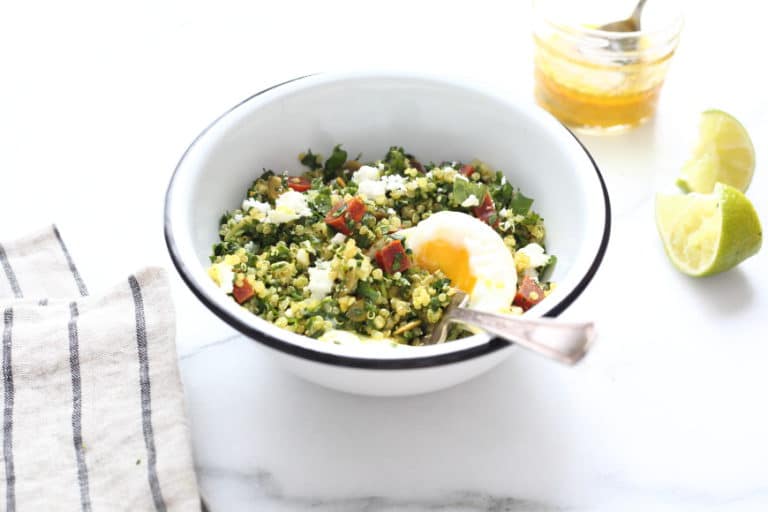



This was a great starting point for using up some parsley in the fridge and a good handful of chives from my garden! I did garlic, lemon, and pumpkin seeds. It went well with our grilled pork tenderloin (seasoned with a south-west chili blend of spices), mushrooms and summer squash, and grilled flat bread! The leftovers will go into my quinoa and greens bowl I'm planning for lunch tomorrow.
That sounds like an absolutely delicious dinner! ❤️
This is an awesome recipe! I have an AeroGarden with Italian parsley, sage, summer savory, mint and holy basil. Some days it feels like the plants overgrow faster than I can consume it, and today I had to clip them all down to keep them from over-crowding. This used them all up and was delicious besides. We poured it over some mushroom ravioli and it felt 5-star restaurant quality in less than 15 minutes.
Woohoo! I’m so happy to hear.
5